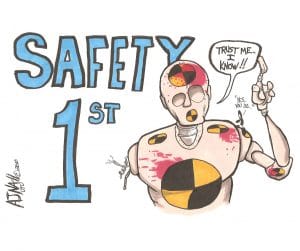
Alternate National Legislative Director Greg Hynes testified Thursday, August 28 at the Federal Railroad Administration’s (FRA) Risk Reduction public hearing.
The FRA published a notice of proposed rulemaking February 27, 2015 requiring certain railroads to develop a Risk Reduction Program (RRP). The Rail Safety Improvement Act of 2008 already requires the development and implementation of railroad safety risk reduction programs.
Risk reduction is a comprehensive, system-oriented approach to safety that: (1.) Determines an operation’s level of risk by identifying and analyzing applicable hazards; and (2.) involves the development of plans to mitigate that risk.
Each RRP is statutorily required to be supported by a risk analysis and a Risk Reduction Program Plan (RRPP), which must include a technology implementation plan and a fatigue management plan.
Below is Hynes’ testimony.
“On April 28, 2015 SMART and six other labor organizations submitted written views on the proposed rulemaking. My testimony will further explain the concerns of SMART.
“I acknowledge that the rail unions agreed to the draft of the risk reduction proposal. However, the proposed rulemaking takes excessive liberty with that tentative agreement. The technical drafting by FRA is not acceptable and we submit it varies from what was approved in the Rail Safety Advisory Committee (RSAC) deliberations.
“I want to reiterate the strong opposition to the Baker Botts study relied upon by FRA to restrict discovery. You should be aware that Baker Botts is a political surrogate for the railroads. The report it submitted reflects this bias. Clearly, the study lacks the objectivity that FRA should have required for an issue so controversial. Its conclusion that the information compiled for the risk reduction plan should be secret is not supported by the statutes it reviewed. FRA needs to recognize that each of the statutes mentioned by Baker Botts limits discovery only in a limited way, and discovery is allowed in every safety statute. The exception is for discovery of governmental documents.
“Our members have voiced great concern that FRA’s proposal here would have a significant negative impact on safety. If a safety hazard exists of which a railroad has knowledge, then the public and railroad employees should not be prevented from knowing such information. Congress has mandated that FRA, in carrying out its duties, shall consider the assignment and maintenance of safety as the highest priority. And it must recognize the clear intent of Congress for the furtherance of the highest degree of safety in railroad transportation. Restricting the public’s access to the railroad’s knowledge of a safety hazard does not comply with the statutory mandate.
“It became clear early in the RSAC working group that FRA was planning to provide the railroads complete protection to keep secret its risk reduction plan. Therefore, it was incumbent upon rail labor to insist that any such information contained therein be compiled “solely” for the risk reduction plan. Any information currently discoverable would continue to be. The problem is that the railroads might attempt to insert many items into the plan and state that they were collected solely for the plan. FRA must clearly specify that such maneuvers would violate the regulation. Also, the labor organizations previously submitted a list of documents that had been discoverable in court proceedings. In order to limit future litigation costs, this list should be restated in the final plan. Otherwise, FRA will be creating a legal nightmare, because the railroads would likely argue in court that almost everything sought was compiled solely for the risk reduction plan.
“Another major concern is that the proposed rulemaking limits the involvement of the collective bargaining representatives in compiling the safety hazards and their mitigation. Unless we are given an equal role, as the railroads to develop the plan many safety hazards likely will be overlooked. The current draft does not comply with the “best efforts and good faith” statutory mandate in development of a railroad’s risk reduction plan. We commend FRA in its explanation of the meaning of best efforts and good faith. However, FRA’s statement in the proposed rulemaking that it will simply “consider” the comments submitted regarding the consultation process requirements when developing the final rule is not acceptable. The workers should be on an equal footing with the railroads in developing the plan. If a railroad does not agree with a union that an issue is a safety hazard, the railroad should be required to show good cause for not including it in the mitigation plan. The railroads must be required to demonstrate substantial grounds not to include an identified safety hazard.
“There are several other points regarding the development of the plan which need to be addressed. FRA has not imposed any time limits upon the industry to consult with the workers or to develop the plan. Rather, the employees are given 60 days notice prior to the consultation. If there are no time limits for completing the plan, then the carriers could drag their feet indefinitely.
“Next, it is not clear why FRA in Appendix B suggests that the railroads should wait one year after publication of the rule to hold substantive consultations. Consultations should begin as soon as possible. Safety delayed is safety denied.
“Another time issue is in section 271.103 (a)(2). The railroads are given 36 months to fully implement the risk–based hazard management plan. If the carriers know the safety problems and how to mitigate them, the plan should be implemented no later than six months after FRA’s approval. There may be minor exceptions only with the approval of the employees.
“In conclusion, in the interests of safety, we strongly encourage FRA to amend the proposed rulemaking in accordance with our suggestions.”
 Eventually, these assessments will complement other programs such as safety inspections of railcars and injury reporting.
Eventually, these assessments will complement other programs such as safety inspections of railcars and injury reporting.